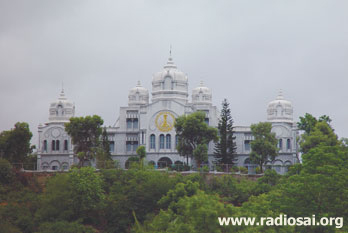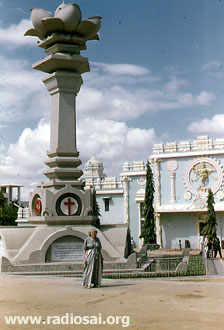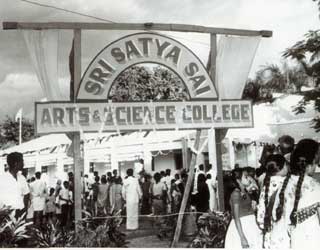 |
 |
 |
Volume
5 - Issue 06
JUNE 2007 |
|
By Prof. G Venkataraman
Unique Philosophy - Unique Personality To put matters in perspective, I would like to begin by referring to two points. The first concerns the philosophy underlying the educational system adopted here, while the second pertains to Swami’s unique relationship with His students. As far as the first is concerned, Swami is quite clear that education must not be reduced to just stuffing the brain; instead, it must address in a balanced manner the needs of the body, the mind, and the soul. Swami often says that Education must be for life and not for merely eking out a living. If life is to be lived the way it really ought to be, then clearly a good and noble character must be the foundation; Integral Education is what facilitates the development and moulding of good character. This system of Integral Education was conceived and crafted by Bhagavan Baba and implemented by the first Vice Chancellor Prof. V K Gokak, from which time it has been operating most successfully.
Ladies First The seeds were sown way back in 1968, when Swami established in Anantapur, a College for women. It was significant that His first College was for women rather than men; that in itself tells a story. One thing about Swami is that once He wills/wishes/decides to do something, He wastes no time in getting started. Thus, without waiting for the buildings to be ready, the Women’s College started functioning right away in temporary quarters. The buildings came later and were duly inaugurated by the then President of India, Mr. V V Giri. That was in the year 1968. Speaking on that occasion, Bhagavan Baba said, “India is being forged into Bhogabhoomi [land of luxury], a land of skyscrapers, tinned food, air-conditioning, and television. Indians are being shaped into an imitative, insurgent, ill-disciplined mass. They are being transplanted on other soils and encouraged to grow without roots. This is an insult to the past and a dangerous defiance of history. It is a sacrilege on the history of Time, and on the sole purpose of the human body. That is the reason I have decided that this College be inaugurated on Gurupoornima Day, as a reminder of the highest tradition, in which the highest ideals of life were instilled by personal example and guidance by the Guru, to pupils eager to imbibe…The seed has been planted; it will sprout and spread, heavy with fruits, providing shade, security, and sustenance to all.” Yes, the seed had indeed been planted, and what a majestic and magnificent tree has emerged from that tiny seed! Education being dear to Swami, He did not stop with merely establishing the Anantapur College. Rather, He became deeply involved in its functioning and made regular visits to Anantapur, spending several days at a time. There, He would talk to students and teachers, listen to Bhajans for extended periods, go on inspection trips around the Campus, and give Discourses. He would even drop into classrooms, sit at the back and quietly listen to the lecture in progress! Dr. Rajeswari Patel, formerly a student of the Anantapur Campus and now a teacher there, recalls those events: "The beautiful thing is He used to come and sit inside the classroom, when the classes were going on. He would sit behind, and listen to the lecture. And if the students turned round to look at Him, which they often did, He would say, 'No, no, turn back and listen to your Teacher!' He used to be that casual!" (From Radio Sai Archives)
Brindavan Blessings The next step in Swami’s Educational Mission was the founding of a College for men in Brindavan. This happened in 1969, and this is how late Mr. Kasturi recalls that event.
"On the opening day, the College looked spick and span ….. On 9th June, 1969 , the Chief Minister of Mysore State, Mr. Veerendra Patil had the honour of inaugurating the College. ….. Speaking on that occasion, Dr. V K Gokak, Vice Chancellor of Bangalore University to which the College is affiliated welcomed the new addition as 'a gem in the crown of the Bangalore University.' Dr. Gokak added, 'This College would set the pattern for College education, not only in the academic field but also in the ethical and spiritual fields. This is a College conceived, devised, and completed by Baba’s Love, Grace, and Wisdom. Brick by brick, plank by plank, He attended to every detail. It is a lesson for all who seek to do sincere loving service.'” (Sathyam Sivam Sundaram - Part III, SSSBPT, Prasanthi Nilayam, 1974, pp.54-55)
"Often, He pats a good student on the back, pulls up a Lecturer who saunters into the Lecture Hall a few minutes after the bell, inquires from a sluggard the percentage of marks he secured at the monthly test, creates a fountain pen or a watch for some diligent, well-behaved boy about whom the Principal has given a report that confirms His own opinion, advises the Librarian about classification, peeps into the dissection room of the budding zoologists and generally moves about as the Guardian Deity of the Institution." (Sathyam Sivam Sundaram - Part III, SSSBPT, Prasanthi Nilayam, 1974, p.58) Kasturi was no doubt a keen witness to all that Swami was engaged in during those days, but it is from the students that we get a more detailed picture, and what an amazing picture that is! Those were the days before the present Trayee came into existence. At that time, there used to be a building known as the “Old Bungalow” which was Swami’s residence. Swami’s quarters were upstairs, and one of the rooms below, which in earlier days had apparently served as a garage, was the Hostel! This gave the boys of that era an unimaginable proximity that students of today would scarcely believe.
'One day, Swami got very angry about the discipline of the students. He told us He was going away and left for Prasanthi Nilayam. We all became upset and did not know what to do. The then Warden blasted us and said, “If you behave like this, you would lose the opportunity to enjoy Divine proximity. Now repent for what you have done.” All the boys prayed intensely and the Bhajan sessions became passionate and emotional; they were very nice. About a week later, Swami wrote a most beautiful and loving letter. He said, “Boys! Though I came off here, I just cannot help thinking about you. All of you are so dear to Me! Even though I went away from there in a huff, you should not become depressed. I did so in the interest of discipline. I want all of you to become good boys, God’s boys! That alone would save you!” That letter really touched us all!' (From Radio Sai Archives) In short, during those glorious Brindavan days, the boys were literally living with God, picking up innumerable lessons most unconsciously. I shall comment on the lessons themselves a little later but let me now offer an example of how close the bond between Swami and the students is, and how He responds to their wishes. The incident happened sometime after the permanent buildings for the Brindavan College had been built – this is the fine edifice that we all see today, beyond the sports field. Though the College had a new building, the students continued to live in the improvised Hostel, and Swami was not too happy about that. So He asked late Col. Joga Rao, a retired Civil Engineer who planned and built all the buildings in those days, to plan a good Hostel for the Brindavan boys. Joga Rao did as told, located a site adjacent to the new College building, got it cleared, drew up a plan for the Hostel, got Swami’s approval and even fixed a date for Swami to lay the foundation stone. On the previous day, Swami dropped in at the temporary Hostel and started talking about the new Hostel, the wonderful facilities it would have, etc. Something amazing happened then, and this is how Mr. Veda Narayanan, then a student and now a Teacher in Swami’s High School for Boys recalls that incident.
"Then we are prepared to move into the new Hostel; otherwise, we would like to stay here, right next to Swami.” Swami was so touched that He immediately sent for Col. Joga Rao and said, “Joga Rao, the boys say they do not want to move from here. Can the Hostel be built right next to the Mandir?” Joga Rao replied, “Swami, that is not possible; there is no place around here. In the only open spot available, we have a tank here.” And then, something amazing happened. Right there, Swami started explaining to Joga Rao how a building could be constructed around the tank! And that is how the Brindavan Hostel came to be where it now is, right next to Swami’s Mandir, all because one boy spoke so feelingly, touching Swami’s Heart!' (From Radio Sai Archives) Lastly a University in Prasanthi Too In 1979, Swami established the third College, this time in Prasanthi Nilayam. Unlike the other Colleges, this was to be substantially a Post-graduate institution. Once again, the classes commenced first in improvised locations, the building coming up later.
Learning by Divine Example By being close and intimate with students and teachers, Swami grants them a chance to observe Him in action. And what is it He wants them to see? He wants them to see how Swami deals with the world. Where dealing with the world is concerned, Swami is very practical. Yes, He does want students to worship God, pray to Him, meditate on Him, and so on. However, Swami does not want them to become monks or recluses. Instead, He wants His students to look at the world and nature in a practical and yet divine way. Take the enforcement of discipline; it has to be a carrot and stick approach. Take games and sports; they are very much needed for a healthy body. However, be careful and avoid aggression; and make sure you do not get hurt. As for food, eat well, but in moderation. Go ahead and eat ice cream if you want to! (In fact, Swami Himself distributes ice cream on many occasions.) But let everything be within limits. You want to go on a picnic? Go ahead and enjoy nature – nothing wrong in it. (In fact, when He goes to Kodai Kanal, Swami Himself takes the boys out for picnic, complete with games and snacks!) The long and short of it is: “Live in this world and don’t try to run away from it. Lead a full life; but live seeing God always and everywhere.” Swami tells us that this is precisely what Emperor Janaka did; and now, He is quietly teaching that same lesson all the time.
All this is fine but does it really work? Does it all rub off on the students, and how do they behave when they go out into the wide world? I can write chapter and verse on this subject but shall restrict myself to citing just one example, a powerful example I might add, brought to public attention by Sanjay Sahni, now Principal, Brindavan Campus. This is what Sanjay said during a Panel Discussion at the time of the Summer Course in 2002. It is all about a Sai student who was caught up in a city torn by riots, and how he put Swami’s teachings into practice in an hour of crisis: There was this youngster who was in Ahmedabad, when the riots broke out. To his utter horror, this boy found that people whom he had known for years, his friends, his neighbours whom he used to address as uncle, people who were well-to-do, people who were well educated, all of them were leaving their homes to join the mob. The mob was in a frenzy and in a killing spree. The youngster asked himself the question: “What should I do? What is my duty? What is my Dharma in this particular situation?” After pondering for a while, the boy came to the conclusion that he would not join the mob; if he did, he would himself turn crazy. He said to himself, “The least I can do is not to join the mob; if I cannot help, at least let me not cause harm.” That is the first principle of service. His next thought was: “I cannot stop the riot; I cannot put out this raging fire. But there are people out there whom I know. Perhaps if I talk to them, I might convince at least some of them not to participate in arson.” He did talk to a few and succeeded in preventing them from joining the mob. To prevent people from doing evil is also service. Finally, he asked himself: “There are so many people affected by the riots. Can I help them in some way, say by talking to them and consoling them?” He did just that. That was positive action, and it did not cost a penny.
Dear Reader, did you find this article helpful? Would you like more articles on the Institute? Please tell us at h2h@radiosai.org mentioning your name and country. Thank you for your time.
|
| You can write to us at : h2h@radiosai.org |
Vol 5 Issue 06 - JUNE 2007
|
Best viewed in Internet Explorer - 1024 x 768 resolution. |















